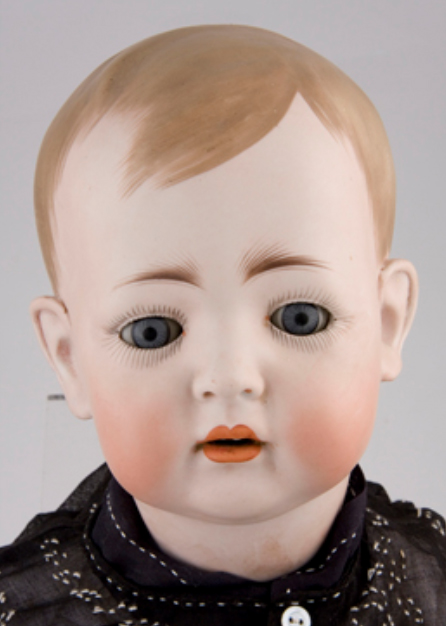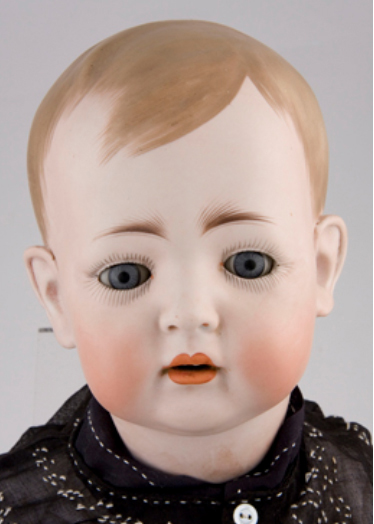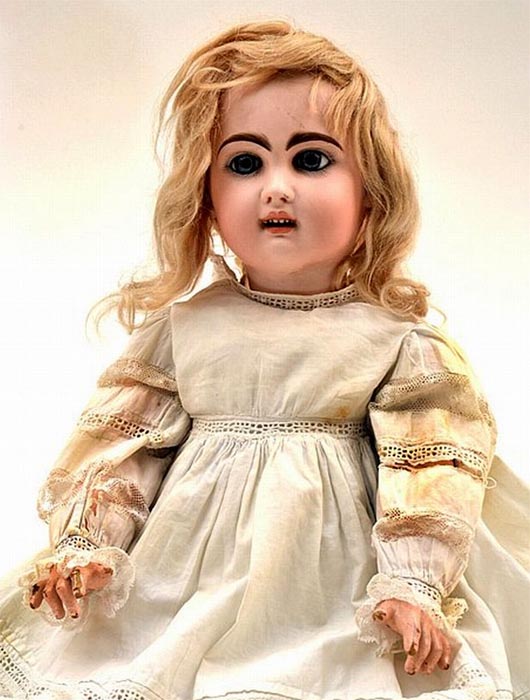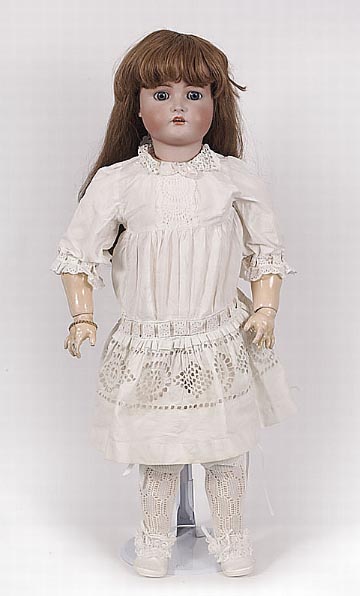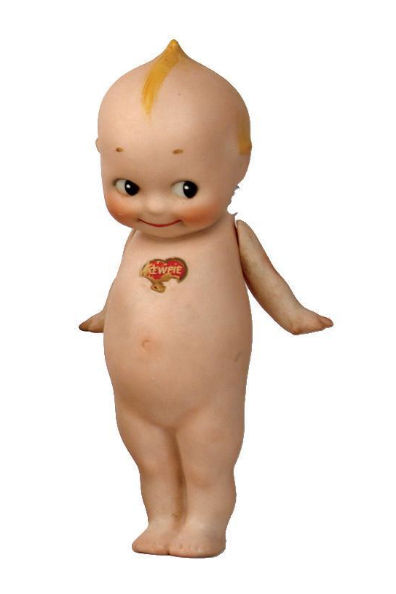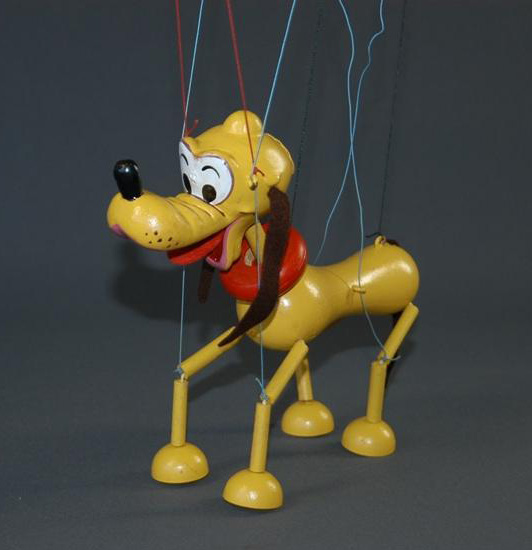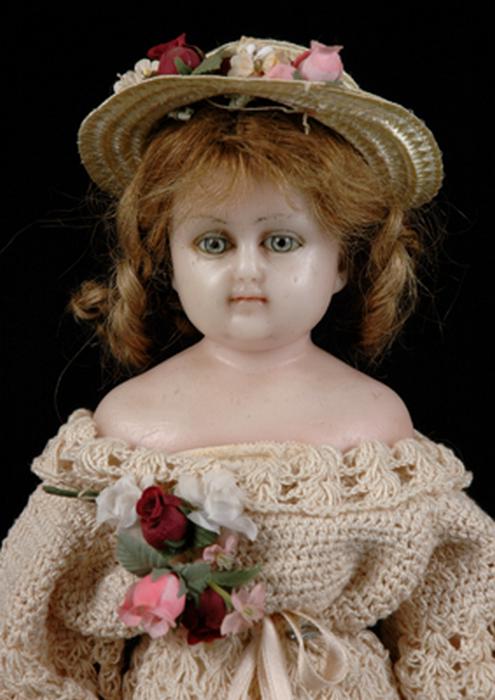Learn about antiques and collectables...
Click on a category below to show all the entries for that category.
Learn about and understand the items, manufacturers, designers and periods as well as the specialist terms used in describing antiques and collectables. Either click one of the letters below to list the items beginning with that letter, or click on a category on the left side of the screen to list the items under that category.
Barbie Doll
"Barbie" was introduced at the American Toy Fair in New York City in 1959 by Ruth and Elliot Handler, who were co-founders of Mattel Toys in 1945. She was inspired by a ‘Lilli’ doll bought by Ruth Handler in Switzerland.
The first Barbie sold for $3.00 and received mixed reviews on release, as she was so unlike any other dolls produced before. However, the public grew to love her and, from 1960s, her popularity became assured.
Looking at the features of a doll help to date it. For example, if she has ‘bubble cut’ hair, she dates from 1961 – 1967. Barbies with ‘pony tail’ hairstyles were produced between 1959 and 1964 and are highly sought after with around six different types available.
Barbie is marked on her buttocks, with the marks helping to date and identify her. The date shown is not the date she was made, but the patent date, meaning she was made sometime after the date shown.
As many Barbies were sold, condition and completeness are vitally important aspects. Dolls that have not been played with, complete examples with boxes and accessories will all be worth more. Most collectors look for examples that show very light signs of wear from play, but are complete – if the condition is better, the value usually rises.
Barbies produced after 1972 are considered ‘modern’ and are of limited interest to most collectors. Those produced before 1972 are deemed ‘vintage’ and are more desirable.
Ruth Handler died in 2002 and her husband Elliot Handler died in 2011.
Chad Valley Toys
Chad Valley is a toy company that was founded in the United Kingdom in the late 19th century. It is known for producing a wide range of toys and games for children, including dolls, action figures, board games, and puzzles. Chad Valley toys are known for their high quality and durability, and they are popular with children and collectors alike. The company was originally founded by Arnold Lowe as a small toy shop in Birmingham, England and it quickly grew in popularity and began producing its own toys, which were sold both in the UK and abroad. In the 1920s, Chad Valley became one of the largest toy manufacturers in the world, and it continued to expand throughout the 20th century. Today, Chad Valley is still a well-known and respected brand in the toy industry.
Character Doll
A character doll is a type of doll that is designed to resemble a specific character or person, often from popular culture. This can include characters from movies, television shows, comics, books, and video games. Character dolls are often highly detailed and accurate representations of the characters they depict, and they may be made of a variety of materials such as plastic, cloth, or porcelain. They are often used as collectibles and may be suitable for children or adults. Some of the most popular character dolls include Disney characters, Barbie dolls, and action figures.
Chiltern Toy Works
Chiltern Toy Works was a British toy manufacturing company that was active from the late 19th century to the mid-20th century. The company was based in High Wycombe, Buckinghamshire, and specialized in the production of lead and cast iron toys, including trains, automobiles, and other vehicles. They are known for their intricate and detailed designs, and many of their toys are considered to be highly collectible today. Chiltern Toy Works was one of the largest and most well-known toy manufacturers in Britain during its time and its products are still highly sought after by collectors. The company was taken over by Chad Valley in 1967.
China Head Dolls
Vintage china head dolls were typically made using a process called "slip casting." This process involved pouring a liquid mixture of porcelain, called "slip," into a mold. Once the porcelain had hardened enough to hold its shape, the mold was opened, and the newly formed porcelain head, hands, and feet were removed. The porcelain pieces were then fired in a kiln to harden them further and remove any remaining moisture. After firing, the dolls' features such as eyes, nose, ears, mouth, and hair were painted on by hand, and the dolls were assembled with a cloth or composition body, and sometimes dressed in period clothing, and had human hair wigs. The dolls were then fired a second time to set the paint and glaze.
Composition
Composition is a material used for dolls, sculpture and furniture. It is a type of composite material made from a mixture of materials such as sawdust, glue, and pigments. It is a popular material for dolls and figurines because it is lightweight and easy to work with. It is also used in furniture-making, particularly in the construction of decorative pieces such as figurines and sculptures. It is less common in high-end furniture as it is not as durable as some other materials such as wood or metal. However, it is a more affordable and accessible option for some types of decorative pieces.
Excelsior
A material made of wood shavings that looks like straw, used as a stuffing in dolls and teddy bears.
Farnell & Co.
Farnell & Co were a British toy and doll manufacturer founded in Notting Hill London in 1840 and were in operation until their closure in 1968. The company was known for producing high-quality dolls and toys, many of which were sold worldwide. Some of its most popular products included teddy bears covered with mohair and rabbit skin, dolls, and mechanical toys. The company's toys and dolls are now considered collectible items and are highly sought after by collectors.
Fixed Eyes
On a doll, fixed eyes are eyes made from glass or similar material (but not painted) that do not move.
J. D. Kestner
Johannes Daniel Kestner founded his business about 1816 and advertisements for his papier mache dolls with leather bodies date to 1823.
He is credited as being the founder of the doll manufacturing trade in the town of Waltershausen, which expanded to become the doll manufacturing centre for all of Europe, with numerous manufacturers based there.
Unlike many of the manufacturers, Kestner was able to produce both heads and bodies. Other manufacturers brought their heads in, as they did not have the plant, such as a porcelain manufactury, to be able to make them in-house.
In the 1850s Kestner was making china-head and wax-over-papier mache dolls but these were unmarked.
Kestner died a wealthy man in 1858 and his two wives carried on the business, purchasing a porcelain factory that produced parian heads and later, bisque heads.
In 1872 Kestner's grandson Adolph took over the business until he died in 1918.
The company continued operating through World War I and into the Great Depression. However the decline in demand, especially from the United States resulted in the company going into bankruptcy in 1936.
Jumeau Dolls
The Jumeau firm was founded in the 1840s, and initially made papier mache dolls. From about 1860 they also made glazed porcelain dolls and later unglazed bisque headed dolls with composition bodies, for which the company is best known. The papier mache and porcelain dolls were unmarked, making it difficult to associate them with Jumeau.
The two types of dolls associated with Jumeau, poupees (fashion ladies) and bebes (child dolls).
Poupees were the most popular type of doll manufactured from the late 1850s through to the 1870s. They had adult bodies, and were dressed in realistic clothing, including shoes, hats and accessories, that mirrored the fashions of the time.
In the late 1870s Jumeau commenced manufacturing the bebe (child) dolls, which had bisque heads, paperweight glass eyes, exaggerated eyebrows. Most had closed mouths until the 1890s.
In the 1890s competition from cheaper German imports threatened the French doll producers and in order to save their businesses, Jumeau and some of the other French manufacturers merged to form SFBJ (the Société Française de Fabrication de Bébés et Jouets.)
Kammer & Reinhardt
The Kammer & Reinhardt doll company was formed in 1886 in Waltershausen, Thuringia, Germany by doll-maker Ernst Kämmer and businessman Franz Reinhardt.
The early Kammer & Reinhardt dolls were made of wax, and while Kammer & Reinhardt bisque doll heads and bodies were designed by by the company, most of the heads were manufactured by another German doll manufacturer, Simon & Halbig. They also purchased bisque heads from the porcelain factories of Kling and Schuetzmeister & Quendt.
From 1886 to 1909 they made dolls with a bisque head on a composition ball jointed body or kid, many with an open mouth with teeth, but after 1909 they diversified into other types of dolls including bisque, composition or celluloid heads, and cloth costume dolls with wired bodies, dressed as various professions.
Kammer & Reinhardt were one of the first producers to use coloured bisque for black, red Indian and oriental dolls, the latter of which had slanted eyes.
However, Kammer & Reinhardt is probably best known for their character baby and child dolls.
In 1902 Kammer & Reinhardt purchased the Heinrich Handwerck doll company and in 1919 they merged with the Simon & Halbig doll company.
After World War II, with their production base in what was then East Germany, all doll producers in the city of Waltershausen, where Kammer & Reinhardt were based, were combined into a single entity to avoid competition amongst the East German manufacturers, and operated as "Biggei".
The Kammer & Reinhardt company is now operating independently again, and still producing dolls.
In January 2013 a Kammer & Reinhardt doll set a world record for the most valuable German made character doll, when a doll modelled by renowned sculptor Arthur Lewin-Funcke of a child dressed in traditional German costume, known as Model 104, was sold for $US212,000 by Theriault's Antique Doll Auctions in California.
The auction house, which specialises in doll sales, currently holds the world record for any doll at auction, set in 2009 by a French model by sculptor Albert Marque, which achieved $US263,000.
Kewpie Doll
The Kewpie character was the invention of artist and cartoonist, Rose O'Neill (1874-1944). She had a strong interest in drawing from an early age, and after winning a prize in a drawing competition at the age of 13, and within two years was employed full-time a an artist for two magazines.
At he age of 19 she moved to New York to further her career, and within a few years became America's first woman cartoonist.
After two failed marriages she moved to live in a cottage in Missouri, and it was here, in 1909 at the age of 25 she created the line drawings for the Kewpie character for which she is so famous.
The line drawings were used by design student Joseph Kallus, to create the Kewpie doll. Kallus worked for Geo. Borgfeldt & Co. who had secured the distribution rights for the Kewpie doll.
The doll was an immediate success and by 1918 there were 21 factories in Germany and the United States producing kewpies to meet the demand experienced by Geo. Borgfeldt & Co.
The various manufacturers each specialised in making Kewpies in different materials. There were all bisque kewpies, celluloid kewpies and cloth and composition versions. Most Kewpies had Rose O'Neill's signature moulded into the one foot, but there were many kewpies made that were unauthorised and unsigned.
Although she became very wealthy from her creation, by 1944 she had lost most of her wealth due to her extravagant lifestyle. She died in 1944 and the rights to the Kewpie passed back to the original designer, Joseph Kallus.
Lenci Dolls and Ceramics
Lenci was founded in 1919 in Turin, Italy by Enrico Scavini, a business agent and his wife, Elena König.
The name ‘Lenci’ was an acronym for Ludus est nobis constanter industria [Play is our constant work]. The couple's first daughter had unexpectedly suddenly died during a Spanish influenza epidemic, and as reaction to the loss, Elena König had started to create rag dolls, imagining that they could be toys for her lost child. Distributed firstly only among the friends of the family, Elena König’s rag dolls soon achieved popularity with the wider public who appreciated them for their simplicity and creative and meticulous workmanship.
Their success was assisted by participation and awards from a number of prestigious trade fairs, including the International Exhibition of Decorative Arts held in Monza in 1923, the Exposition Internationale des Arts Decoratifs et Industriels Modernes in Paris in 1925 and the International Exhibition in Turin in 1928. As the business grew, production encompassed wooden toys, cloth dolls, and furnishings for children's rooms and accessories for women.
In 1928 the company diversified into ceramics, producing figurines, wall plaques and decorative items hiring a number of well-regarded artists and modellers. By 1930 staff numbers had increased to 600, and the company had further diversified into production of ceramics to offset the decline of sales of dolls due to increased competition.
In 1937 the company was sold to Pilade Garella, and the Garella family ensured Lenci’s survival for the next 60 years, until 1997, when ownership passed to Bambole Italiane srl. Lenci continued to trade until 2002, when the company declared bankruptcy and the business was closed.
Open Mouth Doll
An "open mouth" doll is a doll with a mouth that is designed to be open showing moulded or inserted teeth, as if the doll is in the process of speaking or singing. This type of doll was first introduced in the late 19th century and became increasingly popular in the early 20th century. Open mouth dolls were typically made of bisque, a type of unglazed porcelain that is fired at a lower temperature than traditional porcelain. The open mouth design allowed doll manufacturers to create dolls with a more expressive, lifelike appearance, as the open mouth made it possible to add teeth, a tongue, and other features that added to the doll's realism. Open mouth dolls were often dressed in elaborate costumes and accessories, and were marketed to both children and adults as decorative objects.
Pate
The pate in a doll is a rounded piece of either cork or papier mache that covers the wig aperture of a doll, (the opening in the crown of the doll) and provides the base to which the wig can be attached.
Pedigree Dolls
Pedigree dolls were very popular in Australia during the late forties and through the fifties. They came in many sizes and styles.
They were manufactured by Pedigree Soft Toys Ltd. of the United Kingdom, which had factories New Zealand, South Africa and Australia, and was a subsidiary of the biggest toy company in the world from the 1930s to the 1950s: Lines Brothers Ltd.
Pedigree's Sindy was the great success story of the 1960s toy industry, cleverly catching the mood of the new teenage culture. Sindy, first made in 1962 by the Pedigree Company, is the best-selling 'teenage' fashion doll ever produced in Great Britain.
Pedigree, in financial difficulties, sold the Sindy licence to toy giant, Hasbro in 1986, and her popularity with modern children has now been somewhat eclipsed by her rival 'Barbie'.
Pelham Puppets
Pelham Puppets, originally named Wonky Toys Ltd., was founded in 1947 in Marlborough, England by Robert (Bob) Pelham. They originally made small wooden toys and marionettes, but acquired the rights to make Disney character puppets in 1953.
Pinocchio was one of the most popular characters. There were also many versions of Mickey Mouse made over the years, making examples comparatively common as well.
A fire in 1961 resulted in the factory being rebuilt and at the same time the product range was reorganised. Some old lines were dropped and new ranges introduced.
Bob Pelham died in 1980, and business was continued by his wife until 1985 when it was sold. After several more ownership changes, the company went into liquidation in 1993.
The company was revived by a former employee in 2008, and it now produces a number of the old designs as well as new creations.
Early puppets generally tend to be rarer and more desirable, but some of the later puppets are the rarest as fewer were made. Condition is critical as many were produced, collectors will only pay high prices for exceptionally rare characters or for those in the best condition, preferably with a box.
Sleep Eyes
On a doll, sleep eyes are eyes made from glass or a similar material that are open when the doll is upright, and closed when the dollis horizontal.
Wax Dolls
Wax was used by doll makers from the 17th to the 20th centuries. It enabled facial expressions to be skillfully captured, and Victorian wax dolls often represented children in the sentimental manner typical of those times.
Wax dolls are made in one of three ways: poured (into a mold); wax over papier mache or other material and reinforced wax.
Wax dolls did not shatter when dropped like ceramic dolls, but they are easily scratched, or nicked and rapid changes in temperature cause them to crack or distort. Due to the fragile nature of the material, wax dolls have not survived in large numbers.
The best known British wax doll makers of the 19th century are Charles Marsh (1865 - 1914), Lucy Peck (1891 - 1930), Pierotti (1770 - 1942) and Madame Augusta Montanari (1851-1884). Pierotti also supplied heads to other manufacturers. Due to the difficulty of including a permanent marking within the wax, where a manufacturer identified their products, it was usually by a paper label, many of which have come loose and been lost over the years.
Damaged wax dolls cannot be easily repaired, so damage to a wax doll will have a serious effect on its value. The few wax dolls which have retained their original skin tone and feature color, and have no crazing or scratches sell at high premiums.
